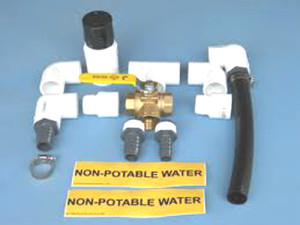 OUR CITY’S CLIMATE ACTION PLAN COORDINATOR ALEX PORTESHAWVER coordinated an interesting and informative graywater workshop this past Saturday. She arranged the workshop and the giveaway of 28 graywater kits to those who attended, installed the laundry graywater kit and committed to an inspection of the kit installation. As I filmed the workshop (see below for a link), I counted more than 30 Benicians in attendance!
OUR CITY’S CLIMATE ACTION PLAN COORDINATOR ALEX PORTESHAWVER coordinated an interesting and informative graywater workshop this past Saturday. She arranged the workshop and the giveaway of 28 graywater kits to those who attended, installed the laundry graywater kit and committed to an inspection of the kit installation. As I filmed the workshop (see below for a link), I counted more than 30 Benicians in attendance!
The graywater kit was specifically intended for diverting washing machine graywater to an outdoor irrigation system. While the installation process is not for the faint of heart, as it involves work both inside and outside the house, the amount of water saved for a single household is really significant.
Washing machines
I have a high-efficiency washer with a front-loading door. And I know, generally, that I save both energy and water, but I really haven’t sat down to calculate my use and savings.
Nor have I wondered — until now — could I be doing better?My machine is an Energy Star HE washer that uses about 15 gallons each load. I tend to wash about four loads each week, so I use about 60 gallons of water.
Calculating that usage out for a full year, 52 times 60, shows I’m using about 3,120 gallons of water. That’s a lot of water down the drain! Imagine having a washing machine that isn’t water efficient in an average American family! That would be about 300 loads of laundry annually times 30 gallons of water — equaling 9,000 gallons of water!
Graywater washing machine kits
The kits with pipes, diverters, valves, clips and hangers costs around $100. There are clear instructions on assemblage and considerations required for the distance, height and pitch required that will allow the flow of water from the washer outside. The hard work remains in designing, trenching and putting the mulch beds in the yard.
There is the usual annual maintenance for the system once installed, and of course if something is washed that shouldn’t be used for watering, the kit allows that water to be diverted into the sewer system. If I put a system in for my home, I personally would consider working with a plumber and landscaper.
Naturally, your detergent selection will be important, along with knowing just what plants will thrive with graywater. All that is carefully described in the workshop video.
Now that I know the cost and effort involved and the water savings possible, this becomes a definite possibility for me — what about you?
Learn more
• sustainablebenicia.org/files/residents/GraywaterApplication.pdf
• energystar.gov/certified-products/detail/clothes_washers
• thisoldhouse.com/toh/tv/ask-toh/video/0,,20565323,00.html (choose scene 3)
Constance Beutel is the chair of Benicia’s Community Sustainability Commission. She is a university professor and videographer and holds a doctorate from the University of San Francisco.







The range of water savings is valid ONLY if you do all your washing during the irrigation season and let the laundry pile up the rest of the year. There is no need to irrigate your garden in the late fall, winter and early spring (sunlight is less, many plants are dormant, temperatures are down and it rains). My garden looked great (better than it does now) all winter with no irrigation. Plus, if you are using graywater, you will want to give the rain a chance to leach out all the extra salt and other chemicals that come into the garden with the graywater. As for water savings? About half of what you calculated, because you should only be irrigating May through October (approximately) in any event…